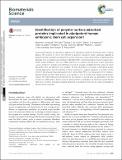Identification of polymer surface adsorbed proteins implicated in pluripotent human embryonic stem cell expansion
Author(s)
Hammad, Moamen; Rao, Wei; Smith, James G. W.; Young, Lorraine E.; Barrett, David A.; Davies, Martyn C.; Denning, Chris; Alexander, Morgan R.; Anderson, Daniel Griffith; Langer, Robert S; ... Show more Show less
DownloadAnderson_Identification of polymer.pdf (4.272Mb)
PUBLISHER_CC
Publisher with Creative Commons License
Creative Commons Attribution
Terms of use
Metadata
Show full item recordAbstract
Improved biomaterials are required for application in regenerative medicine, biosensing, and as medical devices. The response of cells to the chemistry of polymers cultured in media is generally regarded as being dominated by proteins adsorbed to the surface. Here we use mass spectrometry to identify proteins adsorbed from a complex mouse embryonic fibroblast (MEF) conditioned medium found to support pluripotent human embryonic stem cell (hESC) expansion on a plasma etched tissue culture polystyrene surface. A total of 71 proteins were identified, of which 14 uniquely correlated with the surface on which pluripotent stem cell expansion was achieved. We have developed a microarray combinatorial protein spotting approach to test the potential of these 14 proteins to support expansion of a hESC cell line (HUES-7) and a human induced pluripotent stem cell line (ReBl-PAT) on a novel polymer (N-(4-Hydroxyphenyl) methacrylamide). These proteins were spotted to form a primary array yielding several protein mixture ‘hits’ that enhanced cell attachment to the polymer. A second array was generated to test the function of a refined set of protein mixtures. We found that a combination of heat shock protein 90 and heat shock protein-1 encourage elevated adherence of pluripotent stem cells at a level comparable to fibronectin pre-treatment.
Date issued
2016-07Department
Massachusetts Institute of Technology. Department of Biological Engineering; Massachusetts Institute of Technology. Department of Chemical Engineering; Koch Institute for Integrative Cancer Research at MITJournal
Biomaterials Science
Publisher
Royal Society of Chemistry
Citation
Hammad, Moamen et al. “Identification of Polymer Surface Adsorbed Proteins Implicated in Pluripotent Human Embryonic Stem Cell Expansion.” Biomater. Sci. 4.9 (2016): 1381–1391. © The Royal Society of Chemistry 2016
Version: Final published version
ISSN
2047-4830
2047-4849